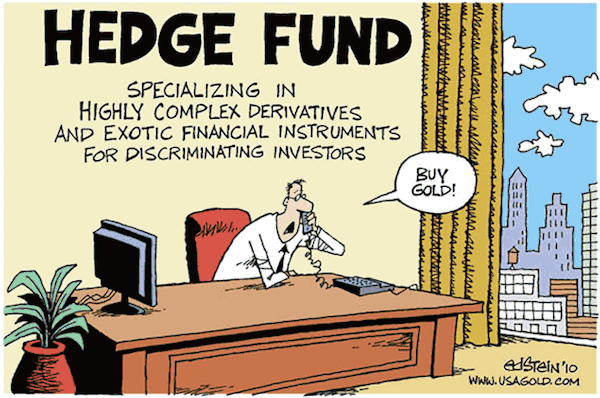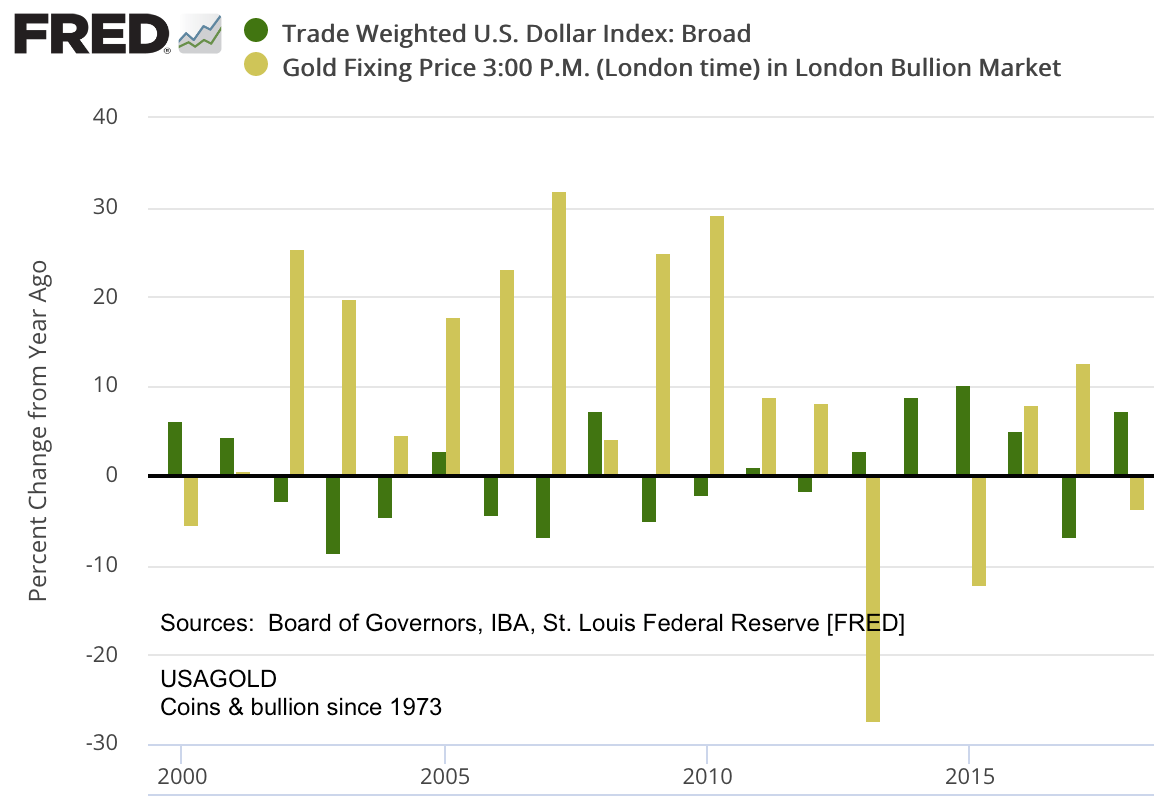Where Are We Now In The Investor Cycle?
In two short months market psychology has undergone radical transformation
Two months ago we warned of October being the month markets have been known to go bump in the night – 1907, 1929, 1987, 1997, 2007, 2008. Sure enough, on October 2 the Dow Jones Industrial closed at 26,828. By the end of the month, it stood at 25,115 – down over 1700 points and nearly 6.5%. Since then stock market psychology has undergone a radical transformation – an abrupt reversal with important implications for the long term. The Wall Street Journal reported recently that "the investor trend that has helped buoy stocks over most of the past decade is showing signs of breaking down."
So where would you put us now in the investor cycle depicted in the chart below?
We guesstimate that we are somewhere between “Euphoria” and “Anxiety” for stocks and “Depression” and “Hope” for gold and silver. In short, the time might be right for starting to leg-out of stocks and ladder-into gold. The last time we featured this chart in late September, we put stock market sentiment at somewhere between “Thrill” and “Euphoria” and gold somewhere between “Despondency” and “Depression.”
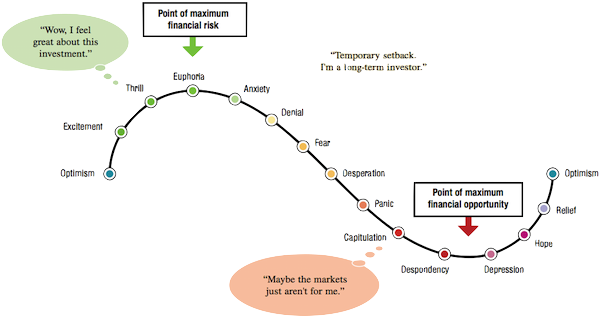
Chart courtesy of OPTIONAlpha
One of Europe’s biggest banks, the Netherlands’ ABN-Amro, weighed-in last week on gold with a strong endorsement for 2019. “We are of the view that the US dollar and US Treasury yields have peaked," sums up Georgette Boele, its Coordinator for Forex and Precious Metals Strategy.
"We also expect that US economic growth," she goes on, "will peak this quarter. During the next two years, we expect lower US economic growth and lower 2y and 10y US Treasury yields. We expect the Fed to hike in December 2018 and one more time in 2019, some time during the first half. Going forward, the 2y US Treasury yields will probably rise in tandem with inflation expectations. So real yields will likely not rise. All these factors support our view that the US dollar has peaked and will weaken in 2019 and 2020. Therefore, we expect gold prices to rally in 2019.”
Paul Tudor Jones says we are in a global debt bubble, 'scary moments' ahead
From CNBC's Fred Imbert: “Billionaire investor Paul Tudor Jones said Thursday that the world has loaded on too much debt which could bring trouble across asset classes. ‘From a 50,000-feet viewpoint, we’re probably in a global debt bubble,’ Jones said at the Greenwich Economic Forum in Connecticut. “Global debt to GDP is at an all-time high.’ ‘This is going to be a very challenging time for policy makers moving forward,’ he said.”
It sounds like Jones is calling current market action the beginning of the end of the present cycle. . .that word “global” before the words “debt bubble” is a bit scary particularly coming from Paul Tudor Jones who has a reputation for consistently making the big calls. This might be the biggest one yet. . . . .
“I remember being told many years ago on a South African game reserve that the buffalo was the most dangerous of the big five game animals. In large part, this is because of the complacency shown towards them relative to the other, more obviously dangerous big five game animals (ie the lion, leopard, rhino and elephant). It’s also a fact that unlike the other big five, the buffalo gives no warning of an imminent charge (see link). It’s complacency that gets you killed, and the same goes for investors with the macro-risks. We all know what the big macro-imbalances are out there, caused by years of loose money, but investors continue to ignore them at their peril.” – Albert Edwards, SocGen
A very old yet very new thought from Mr. Charles Dickens

“It was the best of times, it was the worst of times, it was the age of wisdom, it was the age of foolishness, it was the epoch of belief, it was the epoch of incredulity, it was the season of Light, it was the season of Darkness, it was the spring of hope, it was the winter of despair, we had everything before us, we had nothing before us, we were all going direct to Heaven, we were all going direct the other way – in short, the period was so far like the present period, that some of its noisiest authorities insisted on its being received, for good or for evil, in the superlative degree of comparison only.” – Charles Dickens, A Tale of Two Cities (1859)
Editor's note: Things change little. Things change a great deal. The opening passage to A Tale of Two Cities (1859) – a very old yet very new thought.
'Bear markets are sneaky beasts. . .'
“Bear markets are sneaky beasts," Richard Russell once wrote, "and they like to do their damage as secretly and as unobtrusively as possible. I hate to say it but somewhere ahead, the bears going to get it all together and the innocent little stream is going to turn into a waterfall. What can you do about it? Stay out of the market? Protect yourself by remaining in pure wealth, gold. For thousands of years, silver and gold have been treated as pure wealth. As the standard measures of wealth (stocks and bonds) have deteriorated, veteran investors have forgone profits and moved their assets into pure wealth.”
King World News called the late, great Richard Russell – who regaled us with his wisdom in the Dow Theory Letter for nearly half a century – “the greatest financial writer in history.” A recent Mish Shedlock warning that Americans should expect a “Lost Decade” and that the stock market rout is “just a start,” lit the memory banks and sent me off searching for this old quote. We can only guess what Russell would have had to say about the current state of affairs, but the quote above provides a clue. Never predictable in his opinions, he was rock solid on one axiom throughout his career – the necessity and transcendence of gold as a permanent component of the well-balanced investment portfolio. As he said, so often, it helped him sleep
Why has gold been slow to react to the crisis atmosphere on Wall Street?
The press is recent weeks has been quick to make the argument that gold is reacting to the crisis atmosphere on Wall Street as might be expected. That observation is usually followed-up with a claim that gold has lost its safe-haven status. As the chart below illustrates, gold does not always react to the start of a crisis as expected. As the credit crisis gained momentum in 2008, gold declined as the dollar rose – acting in much the same way it is reacting now to the emerging markets crisis and U.S.-China trade war. It was not until late 2008, when the full extent of the crisis became all too apparent, that it began to move higher. Thereafter, from 2009 to September 2011, it rose to its all-time high of $1895 – a 215% gain in three years.
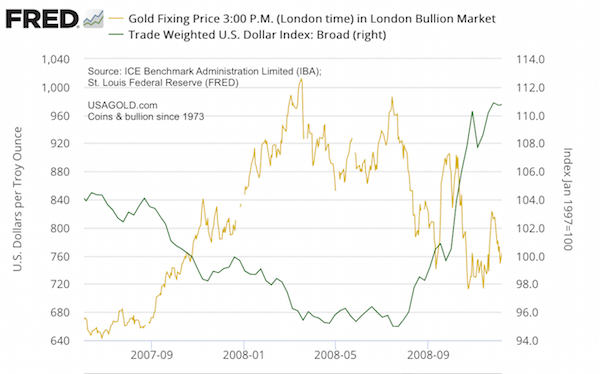
Love. Fear. Inflation. A precious metals' trifecta
“Going forward," says David Smith posting at LawrieOnGold, "there are – and will continue to be – three primary drivers of global physical gold (and silver) demand. During certain times in the past only one or two of these elements provided most of the momentum. However, as we move into 2019, and for possibly the next 5-10 years, all three will be in play. They will operate synergistically to consistently motivate increased precious metals’ buying around the globe. This will happen, even as meeting that demand with sufficient new supply becomes problematic.”
In times past central banks stepped-in to fill the supply-demand deficit, but central banks are now net buyers of the metal and that is unlikely to change under current economic circumstances. In addition, filling that gap from the perspective of global mine production could be problematic as well – particularly in the event of another protracted, full-out financial crisis. China (the #1 producer) and Russia (the #3 producer) both channel their production into domestic reserves. South Africa, once the largest producer, has seen their production dwindle in recent years to where it is now the seventh largest producer. That leaves the United States, Canada and Australia as the primary sources for gold metal. Their combined production at 725 tonnes, however, represents only 18% of annual global demand (+/-4100 tonnes). The potential imbalance is the often overlooked elephant in the gold room.
Paulson & Co keeps stake in gold investments
“Paulson & Co," reports Reuters, "led by longtime gold bull John Paulson, kept its stake in gold investments during the third quarter of 2018 while other heavyweights including Soros Fund Management LLC, Jana Partners LLC and Caxton Corp remained unexposed to the metal.” Some speculate in the metal, other buy and hold. John Paulson is in the latter category as is Bridgewater's Ray Dalio along with several other hedge fund stalwarts.
Since 2000 gold has consistently outperformed the U.S. dollar
Gold has consistently outperformed the dollar in twelve of the last eighteen years – a formidable record. Even if one were to add in average yields on dollar-based investments, gold still comes out the clear winner in those twelve years. Gold is having an off-year thus far in 2018 – down 4.6% while the dollar is up almost 6%. Given the performance record, though, contrarian investors might see the present disparity as a buying opportunity.
Opinion: The next financial crisis will be disinflationary
Much of the discussion among economists these days is centered on the return of inflation. In the interest of equal time, Daniel Lacalle says disinflation, not inflation, will be the culprit in the next financial breakdown. “When the biggest bubble is sovereign debt," he says, "the crisis we face is not one of the massive financial market losses and real economy contagion, but a slow fall in asset prices, as we are seeing, and global stagnation. The next crisis is not likely to be another Lehman, but another Japan, a widespread zombification of global economies to avoid the pain of a large re-pricing of sovereign bonds, that leads to massive tax hikes to pay the rising interests, economic recession and unemployment.”
As pointed out above, gold, to the surprise of its critics, did very well in the during the disinflationary crisis that began in 2007-2008 reaching its all-time high in mid-2011 at over $1800 per ounce. Disinflation, though, is only one of the maladies against which gold serves as a shelter. History has shown it to protect its owners against economic stormy weather of all descriptions – inflation, deflation, disinflation, stagflation and hyperinflation.
Gold ETF assets in steady climb since 2016
This chart shows global net gold ETF assets in tonnes since their inception in 2004. Note the steady overall growth since 2016. Generally speaking, ETFs are the preferred method for gold ownership among funds and institutions. For market-watchers, it indicates the level of interest among professional money managers. As you can see North American growth is up marginally since the beginning of 2016 but European interest has grown markedly. In the United States, stock market over-valuation and interest rates head up fund and institutional concern. Brexit and the possibility of a instability in Italy are at the forefront of European investor concerns.
Notable Quotable
“Well as counter-intuitive as it may sound, people have to hate the market that’s about to take off. Because the more non-believers there are today, the more potential buyers there are who can eventually jump back into the market. We need buyers on the sidelines because for a bull market to be sustained for years at a time, you have to have buyers steadily coming back in. That’s exactly what we have in the gold market right now.” – Zach Scheidt, Daily Reckoning
“Instead, [Hareus' David Holmes] now expects ‘explosive growth’ to come from auto-sector demand for silver as the world shifts away from internal combustion engines. Electric vehicles and hyrid-electric vehicles will account for more than half of global automotive silver demand by 2040 said Thomson Reuters GFMS (now re-named Refinitiv) in its World Silver Survey 2018, produced for the Silver Institute of miners, refiners, dealers and fabricators.” – Adrian Ash, Bullion Vault

Editor's note: Silver still has its roots in industrial demand. As such the burgeoning of uses in the electric automobile industry is of great interest. The 85-1 ratio is also raising a few eyebrows.
“The question is not whether there will be a crisis, but when? In the past 50 years, we have seen more than eight global crises and many more local ones, so the likelihood of another one is quite high. Not just because of the years passed since the 2007 crisis, but because the factors that typically lead to a global crisis are all lining up.” – Daniel LaCalle, Epoch Times
“Europe has brought us a depression worse than 1929. It has led to entire peoples being broken and humiliated, like the Greeks, all for the sake of preserving the infernal instrument of the euro. This whole disaster has been adorned by a chain of lies, shouted ever louder because they are afraid that the colossal damage they have done will be discovered.” – Claudio Borghi, Catholic University of Milan
“Compared with stocks and other financial assets, gold looks inexpensive. More important, inflation is starting to pick up in the U.S. and in much of the world as central banks shrink their enormous balance sheets. And gold has represented a good defense against inflation eroding the value of a stock or bond portfolio.” – Andrew Bary, Barron's

“Even without more spending, the deficits and the resulting mountain of government IOUs are almost certain to tempt politicians to take the easy way out, and let inflation solve the problem they are creating for the economy.” – Irwin M. Seltzer, The Weekly Standard
“GE’s terrifying recent credit meltdown may be the initial pinprick for the corporate debt bubble, but make no mistake – it is not an isolated incident. GE may be the equivalent to Bear Stearns in 2007 and 2008 – just one of the first of many casualties.” – Jesse Colombo, Real Investment Advice
“A large number of European investors have cited gold as the best investment opportunity over the next 12 months, according to a Legg Mason survey. The survey, which polled the views of over 16,000 investors globally, found that about a quarter of those polled in Germany, Italy, Switzerland and the UK identified gold as an investment opportunity.” – Nick Fitzpatrick, Funds Europe

“Gold is scarce. It’s independent. It’s not anybody’s obligation. It’s not anybody’s liability. It’s not drawn on anybody. It doesn’t require anybody’s imprimatur to say whether it’s good, bad, or indifferent, or to refuse to pay. It is what it is, and it’s in your hand.” – Simon Mikhailovich, Tocqueville Funds (with thanks to Ron Stoeferle and Mark Valek at Incrementum AG)
“China and the U.S. have deep and possibly irreconcilable differences. As the the world’s two economic superpowers, they also have an oddly symbiotic relationship. Both want to avoid a full-blown trade war if possible. A fascinating question is which has most to lose, and neither is certain of the answer. They also have a common interest in a weaker dollar.” – John Authers, Bloomberg
“With U.S. economic growth forecast to slow next year, the Fed is widely expected to take a break from hiking rates in the middle of 2019 which will weaken the U.S. dollar. But more importantly, large economies such as Europe, Japan and China are now investing less in global financial markets, so demand for the U.S. dollar will likely reduce." – Hans Redeker, Morgan Stanley, Global head of FX Strategy
“I have tremendous contempt for this market, because every time you try to make money with it, it cuts your heart out. That’s a bear market." – James Cramer, CNBC
“Because of my family background—my grandfather founded Lee Cheong Gold Dealers in Hong Kong in 1950—I believe in the physicality of gold. I would buy a million dollars’ worth of bullion bars and stuff them under my mattress. Gold has underperformed the S&P 500 index for the past five years. SPX has delivered 46 percent in that time, and gold has lost 1 percent. In the next 10 years gold is one of the best contrarian plays. I say buy when no one else does.” – Frederik Balfour, Bloomberg, from article titled "Where To Invest $1 million right now
“Gold is an investment in disorder, not a hedge against inflation.” – James Grant, Grant's Interest Rate Observer
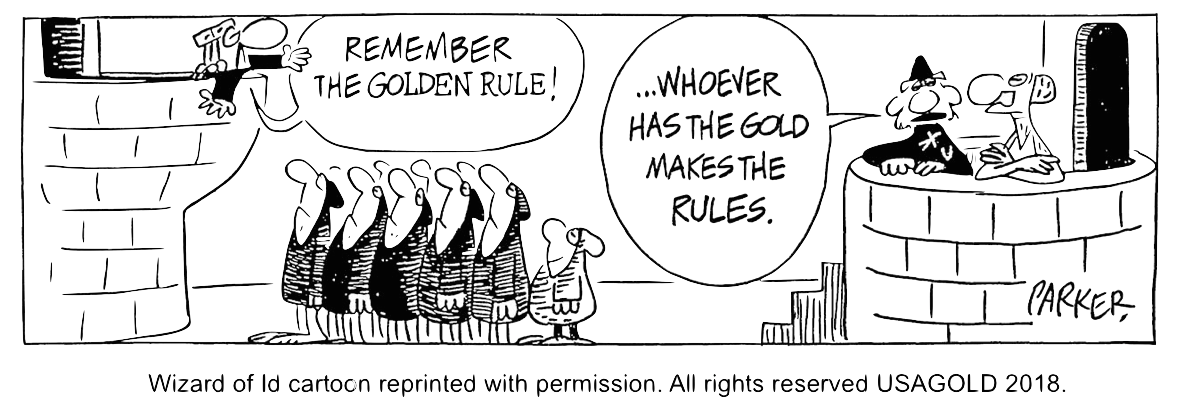
Disclaimer – Opinions expressed on the USAGOLD.com website do not constitute an offer to buy or sell, or the solicitation of an offer to buy or sell any precious metals product, nor should they be viewed in any way as investment advice or advice to buy, sell or hold. USAGOLD, Inc. recommends the purchase of physical precious metals for asset-preservation purposes, not speculation. Utilization of these opinions for speculative purposes is neither suggested nor advised. Commentary is strictly for educational purposes and, as such, USAGOLD does not warrant or guarantee the the accuracy, timeliness or completeness of the information found here. (Please see our Risk Disclosure here.)
Flourish image by Modified by Smasongarrison [CC BY-SA 4.0 (https://creativecommons.org/ licenses/by-sa/4 [Edited]
Michael J. Kosares is the founder of USAGOLD and the author of The ABCs of Gold Investing - How to Protect and Build Your Wealth With Gold. He is also editor and commentator for USAGOLD's Live Daily Newsletter and editor of the News & Views monthly newsletter.
*********






